#brackish fish
Explore tagged Tumblr posts
Text




I'm glad my brackish tank is coming together again. This used to be my brackish community tank, but after my Knight Goby died I admit I paid less attention to it. After catching a Rainwater Killifish locally earlier in the Summer, I picked up some of our local ditch shrimps and tried a native brackish biotope. With no more Rainwater catches after 5 more trips, and the brackish algae dying back for the season, again I was dismayed.
Now after some hornwort addition, some new lighting, and some duckweed growing, it's starting to feel on its way to a real tank again. It's a good feeling.
28 notes
·
View notes
Text
How to care for the spotted scat
One of the iconic fishes for the brackish aquarium, is the spotted or common scat, Scatophagus argus. It is sometimes called a butterfish, although unrelated fishes share that name. The so-called red scat is sometimes traded as a seperate species or race of S. argus, however it is demonstrated to be a naturally ocurring color morph of the spotted scat. Most spotted scats belong to the more typical morph, which is traded as the green scat, or just the scat. This is because the other species appear too rarely in the aquarium trade to have become familiar to aquarists.
The typical length for a mature S. argus, both in the wild and in the aquarium, is 15 to 20 centimeters or 6 to 8 inches. A scat that is 30 centimeters or 12 inches long is considered large, and the recorded length is 38 centimeters, or about 15 inches. This is a venomous fish with a catholic diet, distributed in the Indo-West Pacific region, in a swathe from the Persian Gulf to Japan and Australia. The primary habitat of S. argus is mangrove estuaries, where it associates with mangrove flora.
Mature fish are also found in shallow, inshore marine environments, where they associate with seagrass, rather than reef-building corals. Wether in fresh or brackish water, they are found in areas of muddy substrate. These fish may be numerous in areas of reduced salinity, but records from non-estuarine stretches of rivers are rare. They do frequent upstream stretches of streams, but they remain close to the estuary. Although S. argus can survive in good health when it is maintained in freshwater, I do not consider them a freshwater fish, at any stage in their life cycle.
There are in fact a few related species all called scats, belonging to the extant sister genera Scatophagus and Selenotoca, and the fossil record of the scat clade extends back to the Eocene epoch. Zoologically the scats are part of the acanthuriform nexus of fishes, which is mostly marine, and includes the tangs, butterlyfishes and angelfishes of the reef, among others. Among this group the scats have a reputation as unusually euryhaline, capable of frequenting both fresh and salt waters. Addituonally S. argus also been noted to have broad tolerance of temperature and pH.
Much confusion exists among aquarists, surrounding the salinity needs and optimums of S. argus. Despite their hardiness, unfortunate S. argus suffer and die in home aquariums, or skulk alone in a store. Often aquarists are daunted from purchasing a scat, by misinformation about their needs. Thai aquaculturists report that the culture of S. argus requires a specific gravity, of at least 1.002, or a 'low end brackish' setting. Although scats can be acclimatised to life in true freshwater, it is not their natural habitus.
In a study of wild scats in a mangove environment, the older scats lived where the specific gravity was around 1.02. Juvenile scats were found upstream of them, where tidal influence on salinity was less, and the spe ific gravity was 1.02. Elsewhere it was found that the embryonic development within scat eggs, was optimised when the specific gravity is 1.01. Although some sources insist that scats may only be accommodated in freshwater, if the water parameters are hard and alkaline, collection data shows wild scats are present where the pH may be as low as about 7. It is true that scats are not found where the water has the soft, acidic parameters favoured by so many popular freshwater species.
The genus name Scatophagus, which is obviously abbreviated to the vernacular 'scat', means an eater of faeces. This alleged feeding habit, which causes much amusement, actually remains unproven, although scats have adapted to the human presence on the coast, by frequenting harbours and wharfs. There people dump their latrine and other waste into the water, in the area where fishes such as scats were feeding. Although they might not seek faeces to eat, I feel sure that they obtain some benefit from byproducts of human presence, as do rats and mice, pigeons, seagulls, and the like above water.
Juvenile scats, particularly, are known to consume organic detritus, and mud is intentionally ingested by this species, because it is recovered among their other gut contents. That these scats scavenge opportunistically is the most likely explanation for the presence of fish scales in their gut contents. Because scats are unlikely to nip scales from live fishes swimming by, the most likely source of the ingested scales was nibbling at fish carrion when they encountered it.
S. argus has a very broad dietary range, and the composition of its diet changes with growth. Juvenile scats consume more plankton, but as they grow, they switch to intensify their grazing behaviors, and for this reaon their mouths become subterminal in position. Their diets include a variety of items, from fish eggs, to arthropods, to sessile fauna, and both micro- and macroalgae. Although they are thus most often classed as omnivorous fishes, S. argus has the expanded gut of a herbivorous fish, and the form and function of its teeth and face are optimised for grazing activities.
Depite their strongly herbivorous leanings, a part of the natural S. argus diet includes animals such as sponges, bryozoans, hydroids, and tunicates. One source reports the inclusion of coral and anemone polyps in their wild diet. Unfortunately, the size and systematics of the polyps consumed, was not reported in the paper. Although some saltwater aquarists have maintained older S. argus in reef tanks, where they graze on algae and sessile organisms found on 'live rock', they sometimes nip at delicate, sessile ornamentals such as the popular feather duster worms.
Feeding S. argus in the aquarium is not at all difficult, although the diet provided for them, must be rich in algal or other vegetable material, of the sort offered to herbivorous fishes. Their aquarium environment should be a mangrove biotope, with a soft substrate and wood as decoration. Alternatively the mature S. argus are well suited to a true saltwater lagoon biotope. Such a tank has marine water parameters, a soft substrate, and some calcareous rockwork in the aquascape.
S. argus are regarded as semi-aggressive yet gregarious with their own kind, faring best when housed in a group of conspecifics. Each fish will need not only swimming space, but also a number of retreats from one another. Unfortunately S. argus, being a herbivorous fish, is not unlikely to attack ornamental plants, once it has matured into a more herbivorous growth stage. This means that live plants, including marine macoalgae, will be nibbled or outright devoured, unless they are unpalatable to S. argus.
Juvenile S. argus will require a 'low end brackish' specific gravity, but older fishes occur in 'mid range brackish' to marine environments. Although comparatively few aquarium fishes are inhabitants of brackish waters, there are a variety of peaceful species that are suitable for sharing such a brackish, mangrove biotope. When transferring scats, or any other euryhaline organisms between two aquariums, they must be slowly acclimatised between the two different levels of salinity. This is so that physiological changes can take place, and to prevent osmotic shock.
In their native range, S. argus are found where the water temperature may be as low as 20 degrees centigrade in some months, but up to 29 degrees during other parts of the year. They begin to experience thermal stress, ony at something like 33 degrees, and they can temporarily tolerate such temperatures, but not higher temperatures of around 40 degrees. Like many fish and crabs from mangrove environments, S. argus is well used to thriving at temperatures that are a little higher than those in the average tropical aquarium, which is usually 24 or 25 degrees. Yet S. argus also fares fine at such an ordinary tropical tank temperature.
#Scatophagus argus#spotted scat#common scat#green scat#red scat#misunderstood fish#brackish fish#oddballs#marine fishes#mangrove biotope
0 notes
Text
Captain update: Currently writing a research doc for my dad, who's setting up a brackish aquarium and needed water parameters and tank cycling info. He's getting back into fish keeping and is still a Beginner, but couldn't find any books on Euryhaline fish keeping within aquariums and wanted me to do research for him, which is my specialty! It is 6 pages long so far. It focuses on brackish aquariums and cichlid and community tanks under 40 gallons.
If anyone is interested in having Access to it once it's finished, let me know and I'll update this post with a link! I'm not an expert by far but I've accumulated research from many different sources and will include those sources in the final document !!
If anyone has any recommendations for good sources of info, do let me know as well! It is Difficult to find anything since brackish aquariums are not often marketed to people on a large scale in comparison to freshwater and marine aquariums.
It won't be finished for a while yet, since I plan on waiting until the aquarium is finished so I can add my own experiences and observations to it.
1 note
·
View note
Text


The second image is of a different species, the largescale four-eyes (Anableps anableps). I included it due to how well it shows the eye, and as a result of far fewer photos available of Anableps dowei. This animal was requested!
#pacific ocean#marine fish#pacific coast#southern mexico#to nicaragua#brackish#fish#fishblr#unique animals#livebearer
165 notes
·
View notes
Text
Bonk is just so Shaped.

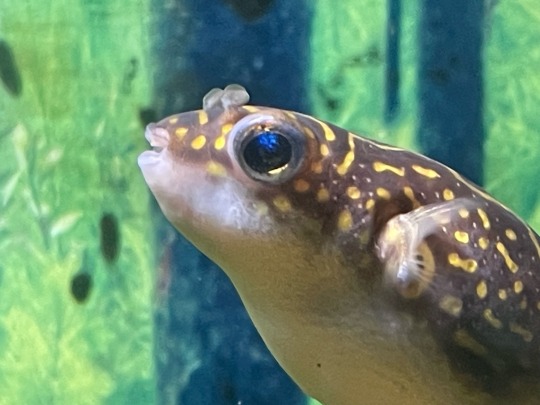


#bonk feesh#f8 puffer#puffer fish#figure 8 puffer#gen and mike’s puffers#fishblr#brackish tank#figure eight puffer#pufferfish
529 notes
·
View notes
Text
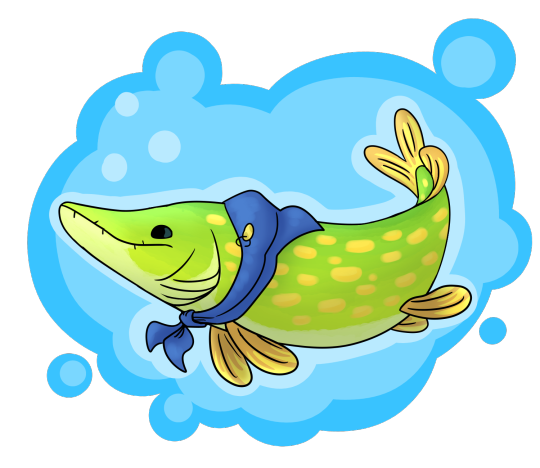
I drew Ahti II's pet pike!! Her name is Kultakutri (Goldilocks) and she's a Golden Royal domestic pike, a breed that has been specifically bred to appear as light and yellow as possible.
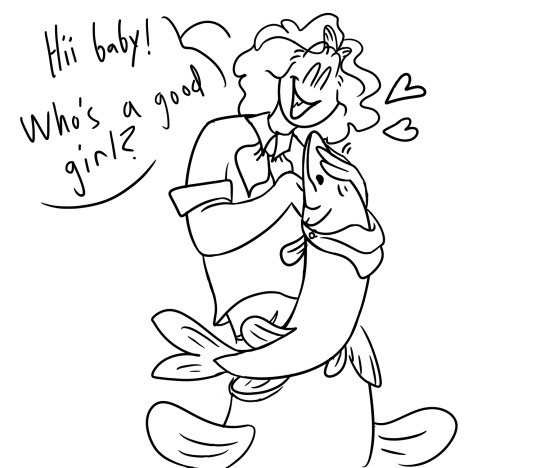
Ahti II raised her from an egg and she’s about ten years old now — doesn’t mean she’s not Baby anymore, though.
#domestic pikes are common merfolk pets in northern hemisphere brackish and freshwater communities#they were and still are frequently used for herding smaller schools of fish but nowadays many are kept as household pets#theyre more independent and temperamental than your average dog but they can be trained to do complicated tasks! usually with a food reward#there are many breeds that have great variety in their colouration size shape and strengths#golden royals are just. Yellow(TM) lmao#my art#art#ahti II#pike#sirpaverse
88 notes
·
View notes
Text
@kenneduck does ur freshwater domain stock algae-based skin care products- Byers is interested- actually both Lio and Byers wanna eat algaE. allies bc of food dghfdsfhg
#i hc my fishes as brackish but theyll get sick in freshwater if staying too long#pri rambles#pri posts
6 notes
·
View notes
Text

Blue 🦀
#blue crab#crab#invertebrates#south louisiana#louisiana#nature#aquarium#fish#fish tank#saltwater#freshwater#brackish#saltwater aquarium#fish eye#macro#macro photography#ocean#gulf of mexico#lake pontchartrain#new orleans#Nola#nolalove
3 notes
·
View notes
Text
I remember when they started educating us about oysters and their importance to the bay! They would set up booths at festivals in Baltimore with aquariums full of oysters. It was very cool - I don't remember the year they started but 2014 seems about right.
Maryland has been working with other states on conservation efforts. We have made steps towards protecting the Chesapeake Bay, which is the largest estuary in the United States. The hard work seems to be paying off!
#baltimore#maryland#charm city#the baltimore you don't know#the baltimore you dont know#inner harbor#national aquarium#Chesapeake#chesapeake bay#chesapeake bay foundation#mid atlantic#estuary#wetlands#marshes#brackish#ecology#oysters#fishing#seafood
2 notes
·
View notes
Text
The genus Brachygobius is a nexus of species in the true goby clade, that are collectively known as bumblebee fishes or bumblebee gobies, in account of their colours and patterning. Often they are seen in dealers aquariums, because they are petite and beautifully colored. Yet much confusion exists as to which exact species is being traded, and what water conditions they might benefit most from, or are natural to the wild gobies. Particularly, the question of proper salinity, with confusion and dubious, repeated 'facts' as to their wild habitats.
B. doriae, B. nunus, and B. xanthozonus in particular, are often confused, and indeed, there is confusion even among ichthyologists, as to which of the Brachygobius species an individual bumblebee fish, or Its population, might belong to. The species of Brachygobius are, in nature, partially separated by environmental niche partitioning, with some species present in wild freshwaters. However, the Brachygobius sp. most usually encountered in the aquarium trade, are in fact from brackish waters.
For instance, B. doriae is sympathetic with Rhizophora mangroves, as well as fish like mudskippers, siganids, and archerfishes, in the muddy lower (and thus tidal) reaches of tropical Asian rivers. Thus this species, chosen as an example, would appreciate a quite higher brackish salinity, than books might suggest. But also, it's presence overlaps with that of the palm, Nypa, which is not as salt tolerant as is Rhizophora, so it would be wrong to reckon B. course as a marine fish.
Smaller Brachygobius species, such as B nunus, might grow to around 1 inch or 2.5 centimetres long. Larger congeneric species of bumblebee fishes, can grow to about 4 centimeters, or over 1 and a 1/2 inches. The small size of these beauties has often appealed to those seeking oddballs or brackish fishes, but finding themself with limited space. Although the male gobies can be territorial to one another, its possible and imperative to house members of these species, in a group of about six or more fishes. Single fishes are too easily stressed, it seems. A combination of factors makes these fish unsuitable for a typical community tank, although with careful thought, they can share with other benign brackish fishes.
Its also worth noting that these gobies appreciate it demand warm end tropical temperatures, higher than the 24 degrees centigrade standard, that is probably the norm for tropical tanks. Perhaps a temperature between 25 and 28 degrees centigrade would be ideal for their aquarium. The wild gobies show a positive association, with a muddy substrate. Again contrary to information in books, these gobies do not need crystal clear water, as they evolved in conditions of turbidity. Their presence in mangrove habitat, means that non-toxic leaf litter and wood, are suitable choices for the aquascape also. Wood could be arranged to imitate the appearance of mangrove roots.
Brachygobius sp. aren't quite as finnicky about eating, as some aquarium literature might lead you to believe. These gobies will, at least if acclimatised, take to defrosted foods, and do not require regular feedings, of love invertebrate prey. Some of them even adjust to nipping proprietary flake foods, although it must be cautioned, most of them will not accept manufactured substitute diets. Given that misinformation about feeding this genus, has daunted many aquarists from attempting bumblebee fishes in the aquarium, it isn't really a basis for most fishkeepers to fret unduly about. Misunderstood fishes that are not eating, are presumably stressed in some way.
0 notes
Note
if you were a fish, which body of water would you live in?
estuary :) best of both worlds babey (salt + fresh water)
#sasha speaks#nablah#i actually like the other creatchures in estuaries more than the fish#like birds and snails and stuff#we have terrapins and horseshoe crabs here :)#but fish also of course are there#and i just like estuaries in general. kayaking on the brackish bay is a beloved annual summer activity for me
5 notes
·
View notes
Text

Bengal Yellowfin Seabream - is a member of the Porgies family and is native to the east coast of India and Sri Lanka east to Myanmar. It is found in both fresh and brackish waters and inhabits warm, shallow, and coastal waters, often entering river mouths and estuaries. It can reach a maximum length of 50 cm (19.7 inches). https://www.redbubble.com/shop/ap/169693343
0 notes
Text
Diversity of Gobies (Actinopterygii, Gobiiformes) in the Rupnarayan River, West Bengal, India

Abstract
A total of 16 species under 13 genera in 4 families of Gobiiformes have been recorded from the Rupnarayan river. Of these Bostrychus sinensis is being reported for the first time from Indian mainland and Bathygobius ostreicola is being recorded for the first time from West Bengal. Four species viz., Acentrogobius viridipunctatus, Butis butis, Taenoides buchanani and Taenioides cirratus are being reported for the first time from Purba Medinipur district and 14 species viz., Acentrogobius viridipunctatus, Apocryptes bato, Bathygobius ostreicola, Boleophthalmus boddarti, Bostrychus sinensis, Butis butis, Butis koilomatodon, Eleotris fusca, Eleotris melanosoma, Odontamblyopus rubicundus, Periophthalmus modestus, Pseudapocryptes elongatus, Taenoides buchanani and Taenioides cirratus are being reported for the first time from Rupnarayan river. Periopthalmus weberi appears to have gone locally extinct in this River.

Introduction
Gobiiformes, the gobies and their relatives, is one of the world's most varied vertebrate lineages with over 2200 species distributed under more than 200 genera (Nelson et al., 2016). Gobies are found in tropical and subtropical waters, especially on coral reefs and estuaries and only 10% of which are found in freshwater (Helfman et al., 2009). Although some species are consumed by man mostly these are prey of economically valuable fish species. Some species are also valuable as ornamental fish (Patzner et al., 2012). Chatterjee and Mishra (2012) reported 174 gobioid species under 69 genera from India of which 45 species under 37 genera are found in Sundarbans of West Bengal (Chatterjee et al., 2013) and 23 species have been recorded so far from Purba Medinipur district (Jayram, 1981; Chatterjee et al., 2000; Yennawar et al., 2015, 2017; Payra et al., 2018; Hossain et al., 2019; Pahari et al., 2020; Khan and Mandal, 2024). Yennawar et al. (2017) and Chatterjee et al. (2000) recorded 14 and 9 species of gobies respectively from the coastal region of Digha, Purba Medinipur district, whereas, Payra et al. (2018) and Khan and Mandal (2024) each have reported 4 species of gobies from Egra and Ramnagar of this district. While Hossin et al. (2019) recorded Butis koilomatodon from Sankarpur, Sit et al. (2020) recorded Glossogobius giuris and Stigmatogobius sadanundio from Purba Medinipur district. River Rupnarayan, however, has remained rather unexplored in this regard. Gobiids recorded so far from this river are Periopthalmus weberi, G. guiris and S. sadanundio as reported by Jayram (1981), Ghorai (2018) and Pahari et al. (2020) respectively. Under such backdrop the present study on the diversity of order Gobiiformes of the Rupnarayan River, which constitutes the eastern border of Purba Medinipur district, was under taken.
Source : Diversity of Gobies (Actinopterygii, Gobiiformes) in the Rupnarayan River, West Bengal, India | InformativeBD
0 notes
Text
i love my pandas so much! They aren't shy and seem to love exploring the tank! They're really interested in my snails tho 👀👀👀
#kass.txt#fish adventures#im currently watching about 3 pabdas and 2 glowlights and 1 shrimpthat are on my bedside of the tank#its very soothing#i had a panic attsck this morning over work#the glass surfjng still stresses me kht but my parameters are good and theyre still new#plus i have a few bronzes who like tk glass surf esp near the air stone#will say tho...the pandas are SUPER interested kn the anubias i have on top of the tunnel#p sure theyre eating the bronze eggs thst were there.#i currently have a clutch in my mini tank im tryiny to hatch#methylebe blue is diffichlt as fuck to find here so im dosing with hydrogen peroxide and day two and no fungus so fingers crossed#my shrimp wont breed whjch js kinda sad but oh well#i read they only breed jn brackish water
0 notes
Text
OP may not have realized it was a Brackish Water tank. They look just like Freshwater tanks, but, if you see cichlids in the tank, even if you see driftwood, leaf litter etc, it may not be truly freshwater.
coworker: hey you should come look at the results of a ph test for a customer’s water
me: I’m king of busy rn
coworker: no really just come here
the ph test:

my honest reaction:

56K notes
·
View notes
Text
Daily fish fact #6 444 205
Fish!
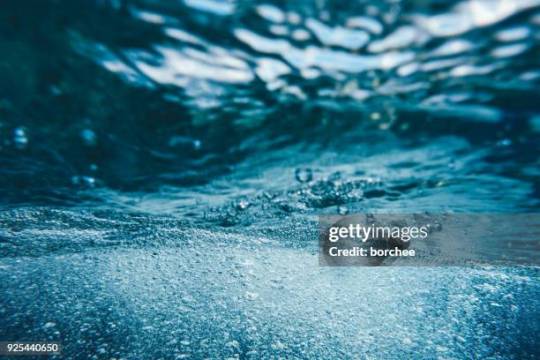
The fish like to have a little drink :) Sadly as they drink the water around them they also drink their own pee, and that is the curse that they will have to live with for the rest of their life
#fish #fishfact #fish facts #fishblr #biology #zoology
( 2 notes )

🪼 clovergonads follow

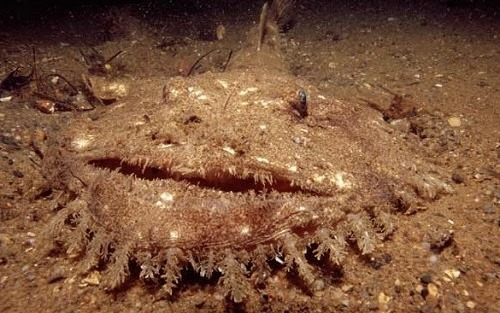

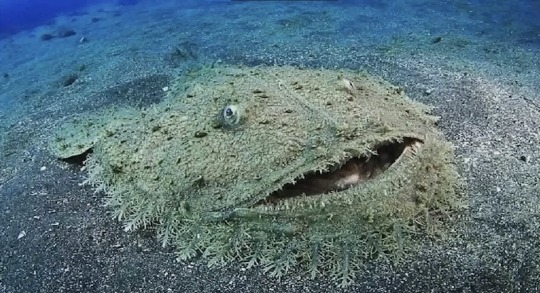
Tasseled wobbegong women >>>>>>>>>>>
🐸 i-eat-skin follow
bitch those are goosefish
( 27,196 notes )

🐚 seashell-on-the-seashore follow
Say what you want about fishblr updates, but I think this format for reblubs is a wonderful improvement over the previous one. One of the only times staff did good.
🐚 seashell-on-the-seashore

@featherstar53 If reblub chains got too long, new reblubs would start appearing as darker and darker until you couldnt see the text anymore. It mimicked how light disappears as you go deeper in the ocean but the sunken code this webbedsite runs on never set a cap for how dark it gets, so eventually you would have to copy ad paste the text on the reblubs onto somewhere to read them.
🐍 swamplamprey follow
It sounds fake but it's true! You can still find some older fishblr post screenshots with this effect:

This even went for full abyssal mode users! In their case, the text would slowly turn from white to dark blue, effectively making it impossible to read against the black background.
🦞 fastest-claw-in-the-west follow
I think it would be super funny if they brought this back but for individual posts. Like the reblubs stay the same colour but the posts themselves get gradually and gradually darker until you can't see them anymore lol. It would be disastrous but also funny and it might finally stop some of you frys from being so addicted to this webbedsite
#im all for a bit of chaos lol #treasure trove: talking tag
( 730 notes )

🌿 invertlike-behaviour follow
Okay for the record. My eyes are Red because I'm a COMMON ROACH! RUTILUS RUTILUS! It's not because I smoke seaweed!
🌿 invertlike-behaviour
Okay Yes I smoke seaweed all day. But the specific reason my eyes are red is Not That
( 104 notes )

🦈 spiritually-placoderm follow
🫧 surgeonsturgeon follow
OP you forgot brackish water and the option for inhabiting both
🦈 spiritually-placoderm
Shut your inferior ass mouth up
🫧 surgeonsturgeon

#(i couldnt find the actual gif i wanted to use but this weird tiger shark will have to do) #(not sure why his fins look like that)
( 1,020 notes )

☀️ slenderfish follow
"ocean sunfish have over 40 parasite species" factoid actualy just statistical error. average ocean sunfish is infected with only one or two parasites. Parasites Georg, the mola who suffers from every ailment known to fish and has over 1 000 000 000 parasite species infesting his flesh and organs, is an outlier adn should not have been counted
( 193,239 notes)

🪷 trout-about-you follow

Selfieeeee :3 (ignore the two sea lampreys attached to my flesh)
🪲 toebiter follow
how did you take the picture you aren't holding your phone
🪷 trout-about-you
The sea lamprey on the left took it for me
( 58 notes )

🔲 salmonidae-supremacy-deactivated


FISH USED TO MIGRATE THOUSANDS OF MILES TO BREED. WHAT THE FUCK IS THIS!!!!
IN MY DAY PUSSFISH LIKE THIS WOULD GET EATEN ALIVE BY REAL RIVER MONSTERS FOR BREAKFAST.
🐟 darting-action follow
these are Siamese fighting fish bruh.... They don't have migration as part of their life cycle lmao
🔲 salmonidae-supremacy-deactivated
OF COURSE THE YOUTH CAN'T PUNCTUATE THEIR SENTENCES PROPERLY. I SHOULDN'T EXPECT SO MUCH FROM THE SOFT FRY THEY ARE. ALWAYS GETTING RILED UP!
🔲 skip-hopper-deactivated
Ignore this guy, @darting-action. He's well known for saying offensive nonsense like this, I think he's bait and trying to get someone to bite.
🔲 salmonidae-supremacy-deactivated
YOU MUST BE ONE OF THOSE INBRED DOMESTIC SCUM OR HATCHED YESTERDAY SINCE YOU ENTIRELY LACK THICK SCALES. I SPEAK THE TRUTH AND ONLY THE TRUTH. IF YOU GET TRIGGERED THEN THAT'S NATURAL SELECTION, SON. YOU SHOULD FIGHT ME IN REAL LIFE.
🔲 walrus-tits-in-my-mouth-deactivated
You really dont know a thing about natural selection, do you? Bettas have flashy fins because they have to seem threatening to possible competitors. They don't migrate so they aren't built for that. They're built for living in ponds and marshes, low oxygen environments, and by cod, they are built for fighting territorial battles! You shouldn't underestimate a fish literally called fighting fish. They're very tough and hardy fish and can even send larger fish fleeing!
🔲 salmonidae-supremacy-deactivated
SIAMESE FLAILING PUSSFISH HAVE LADY FINS BECAUSE THEY'RE WEAK AND SOFT AND HAD HUMANS DECIDE WHO THEY BREED WITH FOR THEM. THEIR QUOTE UNQUOTE "FIGHTING PROWESS" SURE DIDN'T SAVE THEM FROM BEING PRISSY LITTLE PRINCESS FISHIES FOR LITTLE KIDS DID IT? THE INDUBIDABLE FACT IS THAT THEY'RE MUSKIE FOOD.
🔲 iknowthecrabbypattysecretformula-deactivated
Wait a minute... I recongize that picture on the right! That's from @betta-than-this 's OnlyFins! How did you get that picutre hmmm? Salmonidae? How on Ocean did you gain access huh?
🐠 betta-than-this follow
"Indubidable" is a pretty specific word to use. This you @salmonidae-supremacy-deactivated?

🔲 iknowthecrabbypattysecretformula-deactivated
LMAOOOOOO GOTTEMMM!!!!!!!!!!!!!!!!!!!!!!!!!!!!
🔲 aquarium-life-deactivated
HAHAHAHAHAHAHAHAHAHAHAHAHAHAHA
🐟 darting-action
woag i never saw this entire chain before until it hit me on my dashboard. Why does this have so many notes
Thanks fishblr user walrus tits in my mouth for biology info i didn't know
🫖 burgle-the-turts follow
Woah woah woah we're just gonna ignore this guy using p*ssfish as an insult!!???? THE CATFISH SLUR????????? No one is going to bring this up!!!!!???????
🔲 tilapia11128-deactivated
does anyone in this thread smoke seaweed
🌊 herringageposts follow
date of origin: 28th of august, 2017
( 392,229 notes )

🟧 sponsored
Suffering all alone, handsome?
No need to anymore.



👄 pollywannacracker follow
Reblub with your favorite snack in the tags! I’ll go first: coral polyps! :}
🚬 shark-noir follow
@ninjalantern-999
#as for me #my fave is definitely my lower set of teeth when they shed #crumchy :D
( 295 notes )

🩸 must-lunge follow
HAHAHAHAHAHAHAHA STUPID HUMAN DROPPED ITS ELECTRONIC CAMERA IN THE LAKE!!!!!!!! NEVER GETTING THAT BACK BUB!!!!!! I'M TELLING ALL MY ISOPOD AND MUSSEL FRIENDS AND THEY'RE GONNA LIVE INSIDE IT!!!!!
🧑 official-human-posts follow
ofishal human post
#ofishal human post #this post contains humans
( 891 notes )

🦦 hellofromtheotterslide follow
Wait, how come this site is called fishblr and not something like oceanblr or aquablr? Wouldn't that be more inclusive?
👑 goldielocks follow
I believe the name "fishblr" pays homage to the meaning of the word where just about everything in the water was considered a fish. It's why we have words like "shellfish", "whalefish", "jellyfish", "starfish".
Personally aquablr would work really well, too. There's a sizeable amphibious userbase on here.
🦐 worldwideshrimp follow
You forgot whale shark! Those arent fish either but are called fish
👑 goldielocks
....Whale sharks are fish. They are sharks. It's in the name.
🦎 eye-of-newt follow
But I thought it was a whale named after sharks? WHALE shark! Why else would they put whale up first?
👑 goldielocks
A whale named after a shark would be called a shark whale. You can take one look at a whale shark and see that, with its gills and fish tail, it is a shark.
⚪️ number1-seacucumber-ass-enjoyer-77 follow
Wait, then what about baby whales? Are those whales named after babies?
👑 goldielocks
If you're talking about the actual whale babies, then yeah. If you mean the mormyrids, small aquatic animals that can sense electricity, then no, those are fish. Sometimes names are inaccurate to what the animal really is.
🌌 themanta1234 follow
If you think about it, fishblr is also inclusive to aquatic tetrapods since they are lobe-fins, and therefore fish :D It's a term that can include everyone on here, the perfect catchall!
🦑 abyssal-gigantism follow
Ewwww fuck that definition. If mammals hear about them being fish on some sort of """"technicality"""" then this webbedsite is gonna get flooded with those self-important idiots! "OoOoOoOoOoOoOoOOOOO LoOk At MeEeEeEeEEE i'M a MaMmAL!!11!!! I TAKE CARE of mah BAAABIEEEES!1111 I'm SUCH a good MAMAAA!!! All those OTHER STUPID HEARTLESS ANIMALS could NEVER do as I DO!!! I LOVE sweating into my BAABIEEEES' MOUTH1!1!1!111!!! I'm FLUFFY and AWSUM and ERRYBODDY LUUUVSSSSS MEE!!!!!!!!!!111!!!!!!! You should all LUV me TOO!!!!"
Is THAT how you want every fishblr post to look!!!!??????
🦛 drippohippo follow
😨
🪄 magicmanatee45 follow
DD:
🎼 humpbacked-musician-offishal follow
:'''((((
🐋 blainvilles-bitch follow

🕶️ egg-laying-mammal-of-action follow
:///////////
🐢 greenXD follow
i think jellyfish shouldn't be classified as fish because they're clearly living spaghetti
🌜 foolish-idol follow
Great fucking post everyone. Hit the air bubblers
( 60,376 notes )

🟩 ultrahyva-heihoi follow
Guys what the fuck kind of sponsors does fishblr have I just saw an ad for having parasites housed in me who are they advertising to 😭💀💀
#i swear the quality of this site keeps going down and down #if you see ads for parasites then report the shit out of em #fuck em my friend got early onset cataracts due to parasites
( 4 notes )

😃 doweopenandcloseourmouthtoday follow
Yes! :) :O :) :O :) :O :) :O
#fish#fishblr#unreality#unreality tw#dashboard simulator#fake post#fake posts#fakeposting#marine biology#parasite#dead animal#tw dead animal#the fish “reaction” gif that is#polls#shark#sharks#long post
2K notes
·
View notes